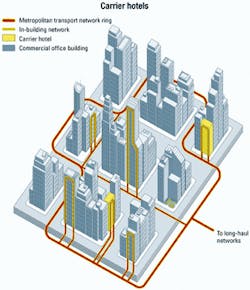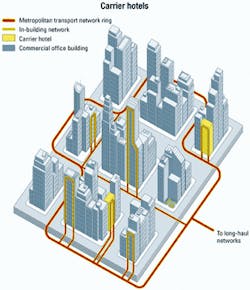Bandwidth trading: a new currency in telecom
Bandwidth trading in the metro has enormous potential to help address the inequalities of bandwidth supply and demand.
TREY FARMER, FiberNet Telecom Group Inc.
Bandwidth trading represents a new way for firms to manage the risk experienced in day-to-day business operations requiring access to bandwidth. Bandwidth trading is a powerful new tool that allows carriers to improve the responsiveness of their networks, reduce capital spending, maximize network utilization, and drastically reduce the overall service delivery time for complex circuits. In today's telecommunications market, carriers operate sophisticated networks and recognize the value of successfully managing the capacity on their backbones.
By creating a market where buyers and sellers can dynamically exchange wholesale capacity, bandwidth trading has the potential to play an important role in the development of next-generation networks. Bandwidth traders are currently focused on broadband transport in the long-haul networks, with the most common routes being New York to Los Angeles, New York to London, and London to Frankfurt. As the long-haul networks continually become more efficient, the bottleneck quickly shifts into the metro.
The major metropolitan markets represent more than an $8 billion opportunity for trading wholesale bandwidth. It is a highly speculative market, but one that will yield significant returns for carriers who are strategically positioned to implement key bandwidth trading initiatives.
Metro bandwidth trading is quickly expected to take off in New York City, the world's largest telecommunications market, due to the incredible number of domestic and international bandwidth hubs located in the city. As bandwidth trading models evolve, the major metropolitan cities will form the nexus of this emerging market in telecommunications.The initial point of connectivity in the metro takes place within the carrier hotels. These large telecommunication hubs serve as the on and off ramps for long-haul networks. Domestic and international carriers such as Qwest, Deutsche Telekom, NTT, Sprint, and MCI/Worldcom enter the metro with virtually infinite capacity. But to directly touch their customers, they must navigate through the metro (see Figure 1). Because all the incoming and outgoing traffic from the large carriers flows through these carrier hotels, they represent the most important real estate in the metro.
As the amount of bandwidth being generated in the metro continues to explode and the group of senders and receivers becomes increasingly diverse, carriers will need new options for transporting their services through the metro. Bandwidth trading allows carriers to efficiently use metropolitan networks and solve the bottleneck of the last mile.
Telecom companies are continually expanding into new markets and announcing cutting-edge products and services. Bandwidth trading has struck a chord in the telecommunications industry and carriers are eager to understand its potential for their business. But the reality is that "trading" bandwidth is a complex process.
Traditional deals for bandwidth in telecom are negotiated as private contracts between buyers and sellers. Weeks, and possibly months, of negotiations between carriers are required to finalize the terms, prices, and conditions of a bandwidth deal. These contracts reflect the particular needs of two parties and cannot be transferred among multiple parties.
For bandwidth trading to succeed, a standard master agreement, or trading contract, must be created. This bandwidth contract needs to facilitate a quick and seamless way for multiple carriers to exchange capacity. By standardizing key terms and conditions in a single contract, buyers and sellers can quickly trade bandwidth.These bandwidth contracts will also allow carriers to negotiate essential elements, such as quality-of-service (QoS), delivery mechanisms, and standard levels of performance. Since trades need to occur at lightning speeds, bandwidth contracts must clarify the offering and allow carriers to focus on the physical delivery of the circuit.
Bandwidth trading faces a great deal of scrutiny, largely due to a lack of definition in the roles of buyers and sellers. Other commodities have distinctive producers and consumers, while bandwidth trading has an ambiguous cast of characters: Any telecom or technology carrier, service provider, or enterprise can buy and/or sell bandwidth. That is because throughout the year, these companies will inevitably have too much or too little bandwidth and can now share excess capacity through simple network connections. The attractiveness of bandwidth trading will surge as the market starts to see a quick and economical path to purchase wholesale bandwidth (on an as-needed basis) and minimize losses by selling excess capacity.
Some market makers, like Enron, have already established trading floors dedicated to bandwidth. These companies are bringing together multiple buyers and sellers and are creating the liquidity and volatility necessary for a dynamic trading environment. Numerous trading models are emerging, and these exchanges are poised to show profitability in the near term. Many energy companies are leveraging their commodity trading expertise into the bandwidth market and targeting numerous areas in broadband.
As trading moves into the metro, it will be necessary to create metro pooling points. These pooling points aggregate the bandwidth demand and supply in a given market and manage the established connections between carriers' networks. Physical trading floors, also referred to as pooling points, have centralized dense network connectivity by aggregating multiple networks on a central switch. The pooling points are the "interconnective tissue" of the market, facilitating a high volume of trading.
Thus far, most trades have been executed on the long-haul routes where the network connectivity is already established. But with the development of metro pooling points, this trading will quickly extend from the long-haul into the metro. This initial metro trading will place carrier hotels at the nerve centers of the bandwidth market.
Pooling points will facilitate the physical delivery of bandwidth and monitor circuit QoS throughout the network. The busiest routes of traffic inevitably begin or end within metro pooling points. For this reason, the greatest opportunity will develop in the metro.
Many pooling points currently under construction are owned and operated by companies that compete directly with medium- to large-sized telecom carriers, which has created concerns about network privacy. Information on the network, including usage and service levels, could potentially be used competitively against a carrier. Consequently, pooling point operators must remain neutral and create an unbiased market. The successful market enablers will be those who maintain strict confidentiality agreements and implement rigorous security procedures.
Telecommunications hubs, such as carrier hotels, allow hundreds of carriers to physically and logically terminate in a single location. These "hotels" have actually been the ultimate enablers of metropolitan telecommunications for decades. They offer a neutral playing field for all carriers requiring metro bandwidth and are perfectly positioned to execute bandwidth trades.
If built within carrier hotels, pooling points reduce the amount of time required to physically execute trades. Currently, it takes approximately three months and capital investment to connect two networks' equipment, monitoring facilities, etc. When three months be comes three minutes, the industry will be poised for an explosion of bandwidth trading. By leveraging the infrastructure in carrier hotels, these unprecedented pro visioning times can quickly become a reality.
The realization of the "three-minute trade" will heavily influence the way networks are built, especially for long-haul carriers. The success of a telecommunications network is, in many ways, defined by the depth and breadth of its connectivity. Carrier hotels and pooling points enable carriers to bring their services to other carriers and thousands of new customers. The rapid trading of bandwidth and networks will accelerate the use of high-capacity voice, data, and video applications. Developing "smart switches" and optical crossconnects will materially increase the value of these networks by reducing the cost of transporting bandwidth.
Emerging markets are speculative by nature.
Were the entertainment industry to deploy new technologies that digitally distribute movies or were banks to adopt new technologies for online transactions, the price of bandwidth could become volatile and subject to price acceleration and deceleration following trends in consumer demand.
Bandwidth trading in the metro has enormous potential to help address the inequalities of bandwidth supply and demand.
As the trading market unfolds over the next few years, bandwidth trading could capture a significant piece of the wholesale metro and long-haul market.
Although the future of wholesale bandwidth trading is uncertain, the successful rollout of any one of the bandwidth trading initiatives will result in a more efficient and robust telecommunications market.
Telecommunications companies providing metropolitan connectivity are poised to enable the creation of an open market for bandwidth trading. It will be exciting to see carrier-and technology-neutral exchanges optimizing networks within the metro-eliminating the metropolitan bottleneck and enabling one of the final frontiers in telecommunications.
Trey Farmer is executive vice president at FiberNet Telecom Group Inc. (New York City). He can be reached via the company's Website, www.ftgx.com.


